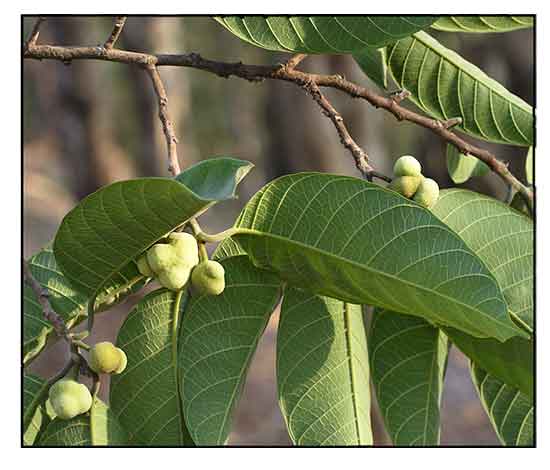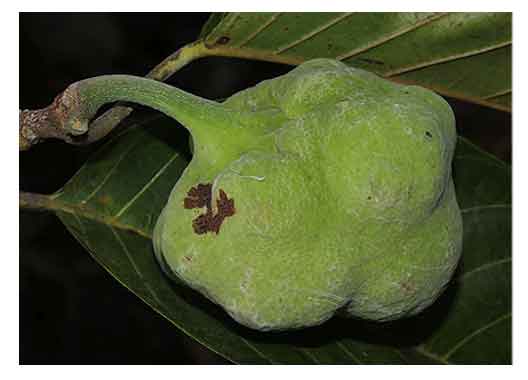 Gen info Gen info
- Etymology: The genus name Artocarpus is derived from Greek words artos meaning "bread" and karpos meaning "fruit".
Botany
Artocarpus gomezianus is a tall tree. Bark covered with gray papery soft cork which splits into parallel vertical fissures, inside light-red with streaks, milky later copious, young shoots puberulous. Leaves oblong or ovate-lanceolate or ovate-oblong, 10-21 x 3-8 cm long, margin entire, acute or acuminate, cuspidate, coriaceous, shining, glabrous, smooth above, sometimes sub-pruinose beneath, lateral veins 7-12 on either side of the midvein, stout and prominent below, base attenuate, obtuse or rounded, petiole 0.5-1 cm long. Flowers intermixed with numerous pedicellate peltate scales, calyx lobes 2, ovate, pubescent, stamen 1, filaments dilated at the apex, anthers exserted, cells transversely dehiscent, divergent. Female receptacle globose or ovoid, 1.5-3 cm across. Anthocarp completely united, few bearing seeds. (3)
Distribution
- Native to the Philippines.
- Also native to Andaman Is, Assam, Cambodia, India, Jawa, Laos, Malaya, Myanmar, Nicobar Is., Sri Lanka, Sumatera, Thailand, Vietnam.
 Constituents Constituents
- Study of ethanol extract of leaves yielded a long chain hydrocarbon, 1-dotriacontanol; a steroid, ß-sitosterol; two triterpenoids, lupeol-3-acetate and simiarenol; and a phenolic glycoside, arbutin. (4)
- Study of heartwood isolated a new compound, artogomezianone (1), along with known compounds cycloartocarpin (2), isocyclomorusin (3), artocarpin (4), norcycloartocarpin (5), norartocarpetin (6), and oxyresveratrol (7). (see study below) (7)
- Qualitative phytochemical screening for secondary metabolites from different fruit samples yielded alkaloids, phenols, flavonoids, tannins, steroids, and saponins. Quantitative analysis showed alkaloids were dominant in all samples, followed by lignin, phenols, flavonoids, tannins, and steroids. (9)
- Study of root bark of A. gomezianus isolated two new 2-arylbenzofurans, namely 13-O-methyl- lakoochin B (1) and artogomezianin (2), along with six known compounds (3-8). (see study below) (10)
- Study of roots isolated eight compounds: Phenyl-β-naphthylamine (1), isocyclomorusin (2), cycloartocarpin (3), artocarpin (4), norartocarpetin (5), cudraflavone C (6), albanin A (7), and resveratrol (8). (see study below) (13)
- Study isolated a new prenylated stilbene, artoindonesianin N (1) and a new prenylated arylbenzofuran, artoindonesianin O (2), along with a phenolic compound, oxyresveratrol (3). (14)
Properties
- Studies have suggest anti-tyrosinase, antiherpetic, antioxidant, photocatalytic, anticancer, antibacterial, antidiabetic, α-glucosidase inhibitory properties.
Parts used
Bark, roots, fruits.
Uses
Edibility
-Fruit is edible, used for making jams and jellies; too sour for eating raw.
- Unripe fruits pickled, eaten with rice.
Folkloric
- No reported folkloric medicinal use in the Philippines.
- Bark used for treatment of burns.
- Used for toothaches and treatment of worms.
Others
- Masticatory: Roots chewed with betel.
Studies
• Tyrosinase Inhibitory Activity / Roots: Study of roots isolated a new dimeric stilbene, artogomezianol (1) and a known compound analasin A (2). Both compounds showed moderate tyrosinase inhibitory activity with IC50s of 68 and 39 µM, respectively. (5) Study of roots isolated eight compounds: Phenyl-β-naphthylamine (1), isocyclomorusin (2), cycloartocarpin (3), artocarpin (4), norartocarpetin (5), cudraflavone C (6), albanin A (7), and resveratrol (8). Compounds 5 and 8 exhibited tyrosinase inhibitory activity. (13)
• ZnO Nanoparticles / Photocatalytic /Antioxidant / Fruits: Study reports on the simple, green, eco-friendly synthesis of ZnO nanoparticles using A. gomezianus extract as fuel by solution combustion synthesis. The NPs exhibited potential photocatalytic activity towards degradation of methylene blue (MB) dye upon exposure to sunlight and UV light. The ZnONPs showed considerable activity against DPPH free radicals. (6)
• Antiherpetic / Flavones / Heartwood: Study of heartwood isolated a new compound, artogomezianone (1), along with known compounds cycloartocarpin (2), isocyclomorusin (3), artocarpin (4), norcycloartocarpin (5), norartocarpetin (6), and oxyresveratrol (7). The isolates were evaluated for inhibitory effects against herpes simplex virus (HSV) type 1 and 2. Compounds 2, 3, 6 and 7 showed moderate activities against both types, while 1,4, and 5 were basically inactive. (7)
• ZnO Nanoparticles / Anticancer / Antibacterial / Fruits: Study reports on the eco-friendly, green combustion method for synthesis of zinc oxide nanoparticles using A. gomezianus fruit extract as fuel. MTT assay showed the good anticancer activity of ZnO NPs against breast cancer cell line (MCF-7). The NPs also showed significant antibacterial activity by zone inhibition method against Staphylococcus aureus and antifungal activity against Aspergillus niger. (8)
• α-Glucosidase Inhibitory Activity / Arylbenzofurans/ Antidiabetic / Root Bark: Study of root bark of A. gomezianus isolated two new 2-arylbenzofurans, namely 13-O-methyllakoochin B (1) and artogomezianin (2), along with six known compounds (3-8). Artogomezianin (2) and lakoochin A (3) exhibited strong α-glucosidase activity with IC50s of 18.25 and 26.19 µM, respectively, as compared to positive control acarbose. (10)
• Antioxidant Activity: Study hydroalcoholic extracts of fruits, aerial parts, and roots for antioxidant activities by nitric oxide scavenging assay, ferric ion reducing activity, ABTS free radical scavenging, and total antioxidant assays. NO radical scavenging was higher in fruit followed by aerial and root parts. ABTS was 5 mg/ml compared to ascorbic acid with 4 mg/ml. Total antioxidant activity was significantly higher for fruits than aerial or root extracts. (11)
• Antidiabetic / α-Glucosidase and α-Amylase Inhibitory Activity / Unripe Fruits: Study evaluated the in vitro alpha-amylase and alpha-glucosidase inhibitory activities of unripe fruits of A. gomezianus. A methanolic extract of A. gomezianus exhibited dose-dependent increase in percentage inhibitory activity of α-amylse (IC50 68.75) and α-glucosidase (IC50 70.29). Acarbose was standard drug. (12)
Availability
Wild-crafted.
|

![]()





